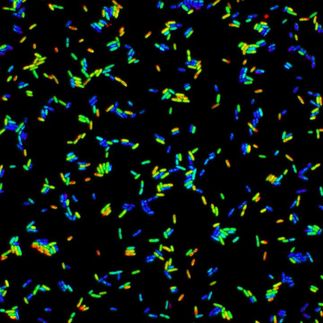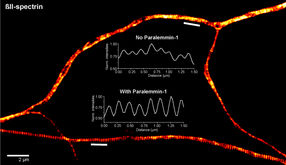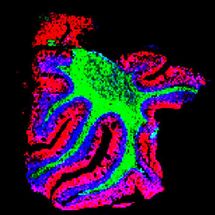New group of antibacterial molecules identified
International research group discovers promising scaffold for antimicrobial agents
Researchers at Karolinska Institutet, Umeå University, and the University of Bonn have identified a new group of molecules that have an antibacterial effect against many antibiotic-resistant bacteria. Since the properties of the molecules can easily be altered chemically, the hope is to develop new, effective antibiotics with few side effects.
The increasing resistance to antibiotics in the world is alarming while few new types of antibiotics have been developed in the past 50 years. There is therefore a great need to find new antibacterial substances.
The majority of antibiotics in clinical use work by inhibiting the bacteria's ability to form a protective cell wall, causing the bacteria to crack (cell lysis). Besides the well-known penicillin, that inhibits enzymes building up the wall, newer antibiotics such as daptomycin or the recently discovered teixobactin bind to a special molecule, lipid II. Lipid II is needed by all bacteria, to build up the cell wall. Antibiotics that bind to this cell wall building block are usually very large and complex molecules and therefore more difficult to improve with chemical methods. These molecules are in addition mostly inactive against a group of problematic bacteria, which are surrounded by an additional layer, the outer membrane, that hinders penetration of these.
“Lipid II is a very attractive target for new antibiotics. We have identified the first small antibacterial compounds that work by binding to this lipid molecule, and in our study, we found no resistant bacterial mutants, which is very promising,” says Birgitta Henriques Normark, professor at the Department of Microbiology, Tumor and Cell Biology, Karolinska Institutet.
In this study, researchers at Karolinska Institutet and Umeå University in Sweden have tested a large number of chemical compounds for their ability to lyse pneumococci, bacteria that are the most common cause of community-acquired pneumonia. The initial tests were carried out in collaboration with the Chemical Biology Consortium Sweden (CBCS), a national research infrastructure at SciLifeLab. After a careful follow-up of active compounds from this screening, the researchers, in collaboration with the University of Bonn in Germany, found that a group of molecules called THCz inhibits the formation of the cell wall of the bacterium by binding to lipid II. The molecules could also prevent the formation of the sugar capsule that pneumococci need to escape the immune system and cause disease.
Molecules that are easy to modify chemically
“The advantage of small molecules like these is that they are more easy to change chemically. We hope to be able to change THCz so that the antibacterial effect increases and any negative effects on human cells decrease,” says Fredrik Almqvist, professor at the Department of Chemistry at Umeå University.
In laboratory experiments, THCz have an antibacterial effect against many antibiotic-resistant bacteria, such as methicillin-resistant staphylococci (MRSA), vancomycin-resistant enterococci (VRE), and penicillin-resistant pneumococci (PNSP). An antibacterial effect was also found against gonococci, which causes gonorrhoea, and mycobacteria, bacteria that can cause severe diseases such as tuberculosis in humans. The researchers were unable to identify any bacteria that developed resistance to THCz in a laboratory environment.
“We will now also initiate attempts to change the THCz molecule, allowing it to penetrate the outer cell membrane found in some, especially intractable, multi-resistant bacteria,” says Tanja Schneider, professor at the Institute of Pharmaceutical Microbiology at the University of Bonn.
Original publication
Elisabeth Reithuber, Torbjörn Wixe, Kevin C. Ludwig, Anna Müller, Hanna Uvell, Fabian Grein, Anders E.G. Lindgren, Sandra Muschiol, Priyanka Nannapaneni, Anna Eriksson, Tanja Schneider, Staffan Normark, Birgitta Henriques-Normark, Fredrik Almqvist, Peter Mellroth; "THCz – Small molecules with antimicrobial activity that block cell wall lipid intermediates"; PNAS; 2021
Most read news
Original publication
Elisabeth Reithuber, Torbjörn Wixe, Kevin C. Ludwig, Anna Müller, Hanna Uvell, Fabian Grein, Anders E.G. Lindgren, Sandra Muschiol, Priyanka Nannapaneni, Anna Eriksson, Tanja Schneider, Staffan Normark, Birgitta Henriques-Normark, Fredrik Almqvist, Peter Mellroth; "THCz – Small molecules with antimicrobial activity that block cell wall lipid intermediates"; PNAS; 2021
Organizations
Other news from the department science

Get the life science industry in your inbox
By submitting this form you agree that LUMITOS AG will send you the newsletter(s) selected above by email. Your data will not be passed on to third parties. Your data will be stored and processed in accordance with our data protection regulations. LUMITOS may contact you by email for the purpose of advertising or market and opinion surveys. You can revoke your consent at any time without giving reasons to LUMITOS AG, Ernst-Augustin-Str. 2, 12489 Berlin, Germany or by e-mail at revoke@lumitos.com with effect for the future. In addition, each email contains a link to unsubscribe from the corresponding newsletter.
Most read news
More news from our other portals
Last viewed contents

Frederick W. Alt and David G. Schatz to be awarded the 2023 Paul Ehrlich and Ludwig Darmstaedter Prize - Laureates raised knowledge of the development of the immune system to a new level
Chemotherapy timing is key to success - Nanoparticles that stagger delivery of 2 drugs knock out aggressive tumors in mice

Call for Entries: Eppendorf & Science Prize for Neurobiology 2017

“Viral relicts” in the Genome Could Fuel Neurodegeneration - Researchers see ancient genes as potential targets for dementia treatment
BASF opens its $33 million facility expansion in Research Triangle Park, North Carolina, USA - State of the art research facilities enable further innovation in crop protection and plant biotechnology
Sanofi invests in new vaccine production facility in France
Monoamine oxidase A: biomarker for postpartum depression - Postpartum mood swings correlated with high monoamine oxidase A binding
Study links vitamin D to lung cancer survival - U-M researchers find high levels of enzyme that blocks vitamin D can predict lung cancer survival, U-M study finds

Isospec Analytics SA - Lausanne, Switzerland
Innovative therapy method for the treatment of brain tumors
Allon Therapeutics announces davunetide receives FDA Fast Track Status for treatment of Progressive Supranuclear Palsy
























































